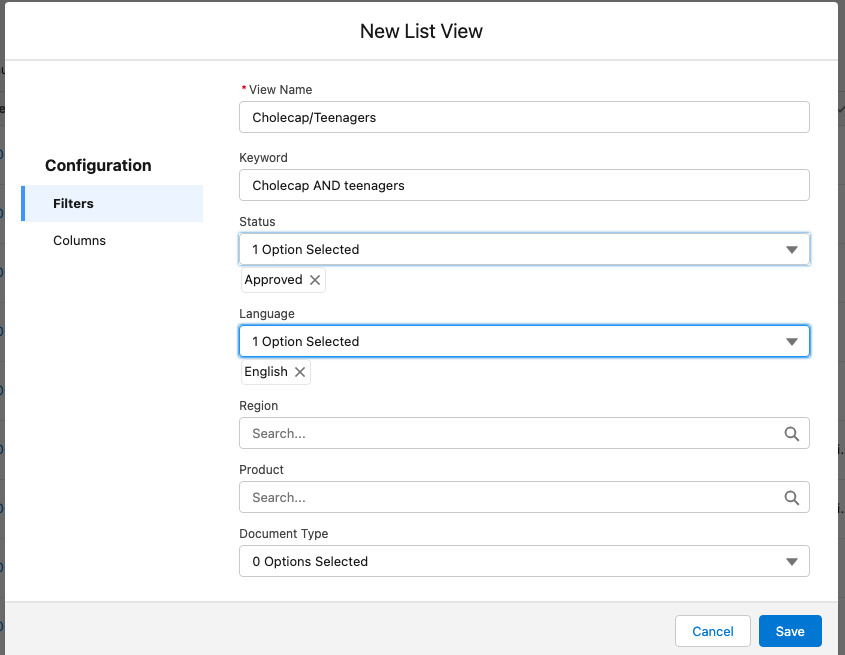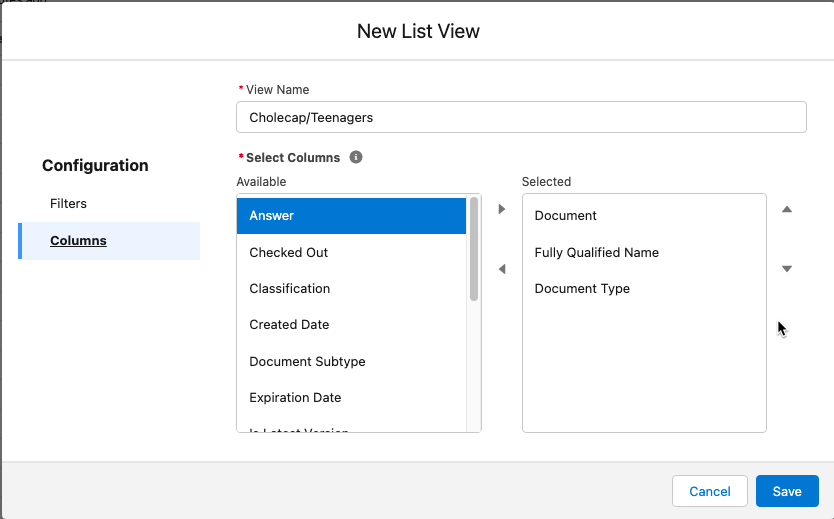Document search
Overview
Medical Information Cloud Content Management offers a document search feature that allows you to easily find documentation to meet your business needs. This feature enables you to conduct document searches using several methods such as list views and filtering, as well by keywords.
Keyword searches are case-insensitive. For example, a search for documents related to medication doses can be executed using Dosing, dosing, or DOSING, all of which will return the proper results. Keyword searches may include search operators to perform more advanced searches.
Search results are ordered according to frequency, uniqueness, location, proximity, and ownership. For more information on search result order, visit Salesforce's How Are Search Results Ordered documentation.

Note
For information regarding document searches in versions prior to V13, click here.
Best practices
Komodo Health recommends you begin searching by creating a View. Doing so helps narrow down the number of records and increases the likelihood you will find the desired results. Additionally, Komodo Health suggests you review all of the sections below, which provide helpful information to assist you in getting the most out of your document searches.
Creating and Managing Views
Creating a View enables you to create a dedicated search using your own specific criteria which can be saved to your profile for future use.
To create a View:
Click the Documents tab. The Documents landing page appears showing all documents (by default).

On the left side navigation menu, click the + next to MY VIEWS or click the gear icon in the top right of the Document page. The New List View modal appears.

Add values to the filter fields.
Note
The available filter fields may vary depending on your organization's configured set of search criteria.
Click the Columns option on the left side of the modal.

Click the desired columns under the "Available" column and then click the forward arrow to move the selection to the "Selected column". Optionally, click a column name in the "Selected" column followed by the back arrow to remove the column from your view.
Click Save. The new View now appears under MY VIEWS in the left side navigation menu.
To edit an existing View:
Click to select the View you want to edit under the MY VIEWS option on the left side navigation menu.
Click the gear icon in the top right corner of the view. A dropdown menu will appear.

Click Edit List View. The Edit List View modal appears.
Adjust the desired values.
Click Save.
Operators
Operators can be used in conjunction with keyword searches.
Note
The following can be found in Salesforce's Find {SearchQuery} developer documentation.
Operator | Description |
|---|---|
* | Asterisks match zero or more characters at the middle or end of your search term. For example, a search for |
" " | Use quotation marks around search terms to find matches in the order you entered your search terms. A search for To include the words “ |
AND | Finds items that match all the search terms. For example, |
OR | Finds items with at least one of the search terms. For example, |
AND NOT | Finds items that do not contain the search term. For example, |
( ) | Use parentheses around search terms with logical operators to group search terms. For example, you can search for:
|
Examples
Keyword | Search Description |
|---|---|
dosing guide | This search returns all records whose fields contain both words: |
dosing OR guide | This search uses the OR logical operator. It returns records with fields containing the word |
dosing AND teenagers | This search uses the AND logical operator. It returns records with fields containing the word |
dosing AND NOT teenagers | This search uses the AND NOT logical operator. It returns records with fields containing the word |
teen* | This is a wildcard search. This search returns all records that have a field value starting with |
“dosing guide” | This search returns all records whose fields contain the words |
Configuration
Document filters can be configured using the CM_Document_Search_Detail layout. Visit Layout configuration for instructions. Document search result columns can be configured using the CM_Search_Result_Columns_Field_Set__c on the CM_List_View_Object_Setting__mdt custom metadata type.
Document searches prior to V13
There are two main ways to find a document:
Basic and advanced document search
Document searches are executed using a combination of SOQL and SOSL. First, any search filters (except for product and region) included in the search are used to execute a SOQL query which returns an initial set of matching documents. Then, a SOSL query is executed against the initial matches to further reduce the search result set. The SOSL query performs a keyword search spanning intelligently selected document metadata and the first 5mb of files.
To search for and find documents in your environment, use basic or advanced document search.
Basic search
Use basic search to search for documents in environments with less than 40,000 total documents. Basic searches are executed when at least one of the following criteria are met:
A keyword is included in the search
A Document Number is included in the search
Product filters are not defined
Region filters are not defined
File contents are not included in the search
Note
If the total number of possible records returned by a basic search is greater than 100 records, an exception is thrown indicating that the maximum number of Document Versions has been reached.
Advanced search
Use advanced search with filtering to narrow the number of Content Document records that are searched in environments with more than 40,000 total documents. Advanced searches are executed when at least one of the following criteria are met:
A keyword is not included in the search
Product filters are defined
Regions filters are defined
File contents are included in the search
If no keywords or filters are included in the search form, the advanced search returns the first page of all documents that the running user can view.
Note
If an advanced search is executed but the filter criteria are not sufficient to narrow the set of Document Versions to less than 20,000 records, an exception is thrown indicating that additional filter criteria must be included.